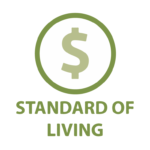
Adult Poverty
Community & Family (Cross Age)
Note
*: Statistically unstable
HHSA Regions: Health and Human Services Agency regions
The end of pandemic-era safety net policies, such as the expanded Child Tax Credit (CTC), in addition to increased costs due to inflation in 2021, were responsible for the observed child poverty increase in 2022.
Race-Ethnicity categories:
White Alone, Black or African American. AIAN: American Indian and Alaska Native, Asian, NHPI: Native Hawaiian and Other Pacific Islander, Some Other Race, Multi-Race: Two or More Races, Non-Hispanic White, Hispanic
Data by race and ethnicity includes possible overlap between racial and ethnic groups, as Hispanic includes population of Hispanic/Latino of all races and each racial group includes population of all ethnicities.
Sources:
U.S. Census Bureau, 2013-2017 American Community Survey 5-Year Estimates, Table B17024; U.S. Census Bureau, 2018-2022 American Community Survey 5-Year Estimates, Table B17024.
U.S. Census Bureau, 2013-2017 American Community Survey 5-Year Estimates, Table B17001; U.S. Census Bureau, 2018-2022 American Community Survey 5-Year Estimates, Table B17001.
U.S. Census Bureau, 2013-2017 American Community Survey 5-Year Estimates, Table B17001A-I; U.S. Census Bureau, 2018-2022 American Community Survey 5-Year Estimates, Table B17001A-I.
Prepared by: County of San Diego, Health and Human Services Agency, Public Health Services, Community Health Statistics Unit, 2024.
What is the indicator?
The indicator—the percentage of adults ages 18-64 living in poverty—reflects the proportion of non-elderly adults living in households with annual income below federal guidelines for “poverty.” The Federal Poverty Level (FPL) was set at $30,000 for a family of four in 2023. These data are routinely reported by the US Census Bureau.
Why is this important?
Poverty, a multifaceted social determinant of health, stems from systemic factors and can perpetuate negative consequences across generations within a family. It manifests when individuals or families lack the means to secure life essentials. Adults facing unemployment or holding low-paying jobs struggle to attain income levels that surpass the poverty threshold. Insufficient resources often lead to inadequate access to food, housing, and community safety. Poverty and low-income status correlate with various detrimental health outcomes, including reduced life expectancy, elevated infant mortality rates, mental health disorders, asthma, heart disease, and obesity. Elevating income levels among low-income households can significantly improve family outcomes.
What strategies can make a difference?
These evidence-based strategies are used across the country to address poverty:
- Simplify application procedures and aid eligible families in enrolling for poverty-alleviation initiatives like childcare subsidies, nutritional aid, financial assistance, and housing support.
- Direct “welfare to work” initiatives towards addressing barriers to employment such as limited education, unstable work records, transportation challenges, substance misuse, and domestic violence.
- Give precedence to housing assistance for pregnant women and families with infants to mitigate housing insecurity, premature births, and infant mortality rates.
- Increase adults’ access to literacy, post-secondary, and vocational education programs.
- Urge employers to eliminate inquiries about previous arrests from job applications (“ban the box”) to mitigate the repercussions of prior arrests or incarceration on employment prospects.